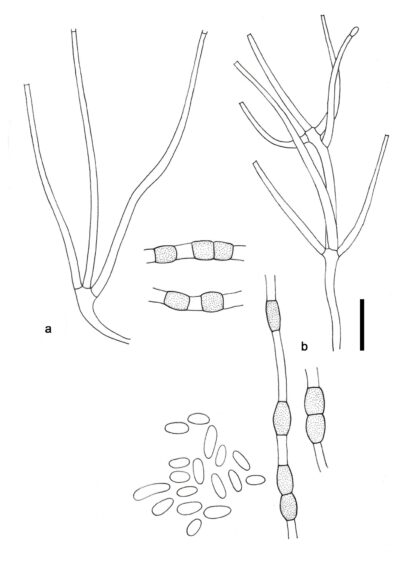Fungalpedia – Note 296, Chlamydocillium
Chlamydocillium Zare & W. Gams
Citation when using this entry: Perera et al. 2024 (in prep) – Fungalpedia, genera described in 2016.
Index Fungorum, Facesoffungi, MycoBank, GenBank, Fig. 1
Classification: Sarocladiaceae, Hypocreales, Hypocreomycetidae, Sordariomycetes, Pezizomycotina, Ascomycota, Fungi
Zare & Gams (2016) established Chlamydocillium based on single species C. cyanophilum, in Hypocreales without assigning to a family. Hou et al. (2023) confirmed that Chlamydocillium nested within Sarocladiaceae in their phylogenetic analysis of LSU, ITS and rpb2 sequences. Currently the genus accommodates nine species (Zare & Gams 2016; Hou et al. 2023; Tan & Shivas 2024). Chlamydocillium species are saprotrophic and mostly soil-borne hyphomycetes (Zare & Gams 2016; Hou et al. 2023). Chlamydocillium is characterized by mycelium consisting of branched, septate, hyaline, thin- and smooth-walled hyphae. Conidiophores are solitary or aggregated, erect or somewhat curved, and develop directly from substratal or aerial mycelium, or from ropes of hyphae. They are either unbranched or basitonously branched, septate at the base or middle section, and occasionally chondroid at the base. Conidiophores produce up to three solitary and/or verticillate phialides per node. Conidiogenous cells are enteroblastic, mono- and polyphialidic, lateral or terminal, subulate, acicular, (sub-)cylindrical, hyaline, thin- or thick- and smooth-walled. Inconspicuous or apparent periclinal thickening and flared or cylindrical collarette can be seen commonly at conidiogenous loci. Adelophialides can be found in some species. Conidia arranged in slimy heads and are usually curved or straight, hyaline, eguttulate or guttulate with thin and smooth walls. They are aseptate and range in shape from cylindrical, bacilliform to ellipsoid, short reniform, or allantoid, with obtuse apices and bases, or somewhat apiculate bases. Crystals are absent. Lateral or intercalary chlamydospores are arranged singly, in pairs, or in short chains. They are solitary, hyaline and range in shape from (sub-)globose, ovoid, limoniform, ampulliform, dolliform, oblong to ellipsoid, with truncated ends and thick walls. The sexual morph remains undetermined (Zare & Gams 2016).
Type species: Chlamydocillium cyanophilum Zare & W. Gams
Other accepted species: Species Fungorum – search Chlamydocillium
Figure 1 – Chlamydocillium cyanophilum (a: CBS 246.74a, ex-type; b: CBS 358.77). a, b Conidiophores, conidia and mycelial chlamydospores. Scale bars: 10 μm. Redrawn from Zare & Gams (2016).
References
Tan YP, Shivas RG. 2024 – Nomenclatural novelties. Index of Australian Fungi 29:1–10.
Entry by
Rekhani Hansika Perera, Center of Excellence in Fungal Research, Mae Fah Luang University, Chiang Rai, 57100, Thailand.
(Edited by Kevin D. Hyde, Samaneh Chaharmiri-Dokhaharani, & Achala R. Rathnayaka)
Published online 8 July 2024
